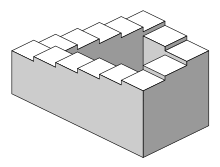
Back درج بنروز Arabic Penrouz pilləkənləri Azerbaijani Стълби на Пенроуз Bulgarian পেনরোজ সিঁড়ি Bengali/Bangla Escala de Penrose Catalan Penrose-Treppe German Ŝtuparo de Penrose Esperanto Escalera de Penrose Spanish پلکان پنروز Persian Penrosen portaat Finnish

The Penrose stairs or Penrose steps, also dubbed the impossible staircase, is an impossible object created by Oscar Reutersvärd in 1937[1][2][3][4] and later independently discovered and made popular by Lionel Penrose and his son Roger Penrose.[5] A variation on the Penrose triangle, it is a two-dimensional depiction of a staircase in which the stairs make four 90-degree turns as they ascend or descend yet form a continuous loop, so that a person could climb them forever and never get any higher. This is clearly impossible in three-dimensional Euclidean geometry but possible in some non-Euclidean geometry like in nil geometry.[6]
The "continuous staircase" was first presented in an article that the Penroses wrote in 1959, based on the so-called "triangle of Penrose" published by Roger Penrose in the British Journal of Psychology in 1958.[5] M.C. Escher then discovered the Penrose stairs in the following year and made his now famous lithograph Klimmen en dalen (Ascending and Descending) in March 1960. Penrose and Escher were informed of each other's work that same year.[7] Escher developed the theme further in his print Waterval (Waterfall), which appeared in 1961.
In their original article the Penroses noted that "each part of the structure is acceptable as representing a flight of steps but the connections are such that the picture, as a whole, is inconsistent: the steps continually descend in a clockwise direction."[8]
- ^ Penrose Stairs. Benedikt Taschen. 1992. ISBN 9783822896372. Archived from the original on 23 November 2022. Retrieved 9 October 2020.
- ^ Torre, Matteo. "Impossible Pictures: When Art Helps Math Education" (PDF). Impossible Pictures: When Art Helps Math Education. Retrieved 9 October 2020.
- ^ "Endless staircase". Impossible World. Retrieved 9 October 2020.
- ^ Cite error: The named reference
IllusionWorkswas invoked but never defined (see the help page). - ^ a b Penrose & Penrose 1958, pp. 31–33
- ^ YouTube, ZenoTheRogue, Ascending and Descending in Nil, retrieved 2022-07-09
- ^ Hallyn 2000, p. 172
- ^ Ernst 1992, p. 72